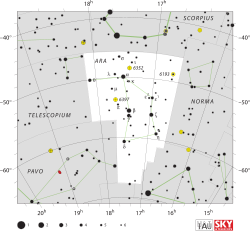아래1 로
Rho1 Arae| 관측 데이터 에폭 J2000 이쿼녹스 J2000 | |
|---|---|
| 별자리 | 아라 |
| 우측 상승 | 16h 56m 08.8405s[1] |
| 탈위임 | –50° 40′ 29.244″[1] |
| 겉보기 크기(V) | 6.275[2] |
| 특성. | |
| 스펙트럼형 | B3 Vnpe |
| U-B색지수 | –0.691[2] |
| B-V색지수 | +0.008[2] |
| 아스트로메트리 | |
| 방사 속도(Rv) | +19km[3]/s |
| 적정운동(μ) | RA: –7.66[1]mas/yr Dec.: –9.79[1]mas/yr |
| 시차(시차) | 5.06 ± 0.39 마스[1] |
| 거리 | 640 ± 50 리 (200 ± 20 pc) |
| 절대치수(MV) | −0.16[4] |
| 세부 사항 | |
| 미사 | 6.3 ± 0.1[5] M☉ |
| 루미도 | 1,418[6] L☉ |
| 표면 중력(log g) | 3.75[7] cgs |
| 온도 | 19,800[7] K |
| 회전 속도(v sin i) | 370 ± 10[8] km/s |
| 나이 | 18.4 ± 1.5[5] 마이어 |
| 기타 지정 | |
| 데이터베이스 참조 | |
| 심바드 | 자료 |
Rho1 Arae는 아라의 남쪽 별자리에 있는 별의 바이엘 명칭이다.바이엘(Bayer)이라는 이름이 붙은 별의 경우 유별나게 그의 우라노메트리아에서 바이엘(Bayer)에 의해 목록화되지 않았다.대신 니콜라스 라카유에 의해 1763년에 출판된 그의 코엘럼 오스트랄레 스텔리페룸에 처음으로 목록화되었다.이 별은 1801년에 출판된 보데의 천왕성계에 있는 로1 아래의 바이엘 명칭을 얻었다.Rho1 Arae는 Bayer로 명명된 가장 희미한 별들 중 하나로, 겉으로 보이는 시각적 크기가 +6.275에[2] 불과하다. Bortle Dark-Sky Scale에 따르면, 이것은 이 별이 어두운 시골 하늘에서 육안으로 거의 보이지 않는다는 것을 의미한다.시차 측정에 따르면, 태양으로부터 약 640광년(200파섹) 떨어져 있으며, 50광년의 오차범위를 주거나 갖는다.[1]
이것은 분광형 이항계인데, 이는 궤도를 선회하는 동반자의 존재가 스펙트럼의 변화에 의해 표시된다는 것을 의미한다.그러나 1차 부품은 370 ± 10의 예상 회전 속도로 빠르게 회전하기 때문에 신뢰할 수 있는 궤도 원소를 얻기 어렵다.궤도 주기는 0.439일로 추정되었다.이 시스템의 스펙트럼은 1차 항성이 B형 주계열성임을 나타내는 B3 Vnpe의 별 분류와 일치한다.'e' 접미사는 방출선이 존재함을 나타내며, 이것이 Be star임을 나타낸다.Rho1 Arae의 경우 방출선이 두드러지고 가변적이다.[8]
Rho1 Arae는 이웃에 비해 27.4 ± 4.9 km/s의 특이한 속도를 가지고 있어,[5] 가출성 항성계통이다.과거 초신성 폭발의 결과로 스콜피우스-센타우루스 OB 협회에서 배출된 시나리오는 그 빈약성 때문에 가능성이 희박해 보인다.[8]
참조
- ^ a b c d e f van Leeuwen, F. (November 2007), "Validation of the new Hipparcos reduction", Astronomy and Astrophysics, 474 (2): 653–664, arXiv:0708.1752, Bibcode:2007A&A...474..653V, doi:10.1051/0004-6361:20078357, S2CID 18759600.
- ^ a b c d Kozok, J. R. (September 1985), "Photometric observations of emission B-stars in the southern Milky Way", Astronomy and Astrophysics Supplement Series, 61: 387–405, Bibcode:1985A&AS...61..387K.
- ^ Evans, D. S. (June 20–24, 1966), "The Revision of the General Catalogue of Radial Velocities", in Batten, Alan Henry; Heard, John Frederick (eds.), Determination of Radial Velocities and their Applications, Proceedings from IAU Symposium no. 30, vol. 30, University of Toronto: International Astronomical Union, p. 57, Bibcode:1967IAUS...30...57E.
- ^ Anderson, E.; Francis, Ch. (2012), "XHIP: An extended hipparcos compilation", Astronomy Letters, 38 (5): 331, arXiv:1108.4971, Bibcode:2012AstL...38..331A, doi:10.1134/S1063773712050015, S2CID 119257644.
- ^ a b c Tetzlaff, N.; Neuhäuser, R.; Hohle, M. M. (January 2011), "A catalogue of young runaway Hipparcos stars within 3 kpc from the Sun", Monthly Notices of the Royal Astronomical Society, 410 (1): 190–200, arXiv:1007.4883, Bibcode:2011MNRAS.410..190T, doi:10.1111/j.1365-2966.2010.17434.x, S2CID 118629873.
- ^ Hohle, M. M.; Neuhäuser, R.; Schutz, B. F. (April 2010), "Masses and luminosities of O- and B-type stars and red supergiants", Astronomische Nachrichten, 331 (4): 349, arXiv:1003.2335, Bibcode:2010AN....331..349H, doi:10.1002/asna.200911355, S2CID 111387483.
- ^ a b Soubiran, C.; Le Campion, J.-F.; Cayrel de Strobel, G.; Caillo, A. (June 2010), "The PASTEL catalogue of stellar parameters", Astronomy and Astrophysics, 515: A111, arXiv:1004.1069, Bibcode:2010A&A...515A.111S, doi:10.1051/0004-6361/201014247, S2CID 118362423.
- ^ a b c Jilinski, E.; et al. (September 2010), "A Dynamical Study of Suspected Runaway Stars as Traces of Past Supernova Explosions in the Region of the Scorpius-Centaurus OB Association", The Astrophysical Journal, 721 (1): 469–477, Bibcode:2010ApJ...721..469J, doi:10.1088/0004-637X/721/1/469.
- ^ "rho01 Ara". SIMBAD. Centre de données astronomiques de Strasbourg. Retrieved 2012-08-01.
{{cite web}}: CS1 maint : 포스트스크립트(링크) - ^ "MAST: Barbara A. Mikulski Archive for Space Telescopes". Space Telescope Science Institute. Retrieved 8 December 2021.




